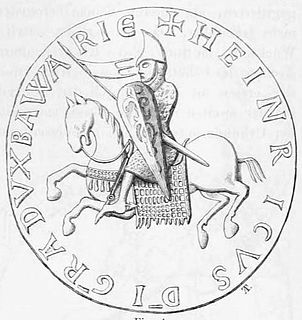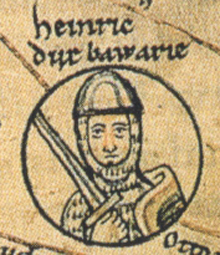Related Research Articles
Henry the Proud, a member of the House of Welf, was Duke of Bavaria from 1126 to 1138 and Duke of Saxony as well as Margrave of Tuscany and Duke of Spoleto from 1137 until his death. In 1138 he was a candidate for the election as King of the Romans but was defeated by Conrad of Hohenstaufen.
Baldwin I, also known as Baldwin Iron Arm, was the first margrave of Flanders, which evolved into the County of Flanders.
Frederick II, called the One-Eyed, was Duke of Swabia from 1105 until his death, the second from the Hohenstaufen dynasty. His younger brother Conrad was elected King of the Romans in 1138.

Henry II, called Jasomirgott, a member of the House of Babenberg, was Count Palatine of the Rhine from 1140 to 1141, Duke of Bavaria and Margrave of Austria from 1141 to 1156, and the first Duke of Austria from 1156 until his death.

Arnulf, also known as the Bad or the Evil, a member of the Luitpolding dynasty, held the title of Duke of Bavaria from about 907 until his death in 937.
Rudolph I was King of Upper Burgundy from his election in 888 until his death.

Welf I or Welfo was a Swabian nobleman. He was a member of the Elder House of Welf.
The Elder House of Welf was a Frankish noble dynasty of European rulers documented since the 9th century. Closely related to the Carolingian dynasty, it consisted of a Burgundian and a Swabian group. It has not been definitively clarified, however, whether the two groups formed one dynasty or whether they shared the same name by coincidence only. While the Elder House became extinct in the male line with the death of Duke Welf of Carinthia in 1055, his sister Kunigunde married into the Italian House of Este and became the ancestor of the (Younger) House of Welf.
Judith of Bavaria was the Carolingian empress as the second wife of Louis the Pious. Marriage to Louis marked the beginning of her rise as an influential figure in the Carolingian court. She had two children with Louis, Gisela and Charles the Bald. The birth of her son led to a major dispute over the imperial succession, and tensions between her and Charles' half-brothers from Louis' first marriage. She eventually fell from grace when Charles' wife, Ermentrude of Orléans, rose to power. She was buried in 843 in Tours.

Welf I is the first documented ancestor of the Elder House of Welf. He is mentioned as a count (comes) in the Frankish lands of Bavaria.

Henry I, a member of the German royal Ottonian dynasty, was Duke of Bavaria from 948 until his death.

Welf I was Duke of Bavaria from 1070 to 1077 and from 1096 to his death. He was the first member of the Welf branch of the House of Este. In the genealogy of the Elder House of Welf he is counted as Welf IV.

Henry IX, called the Black, a member of the House of Welf, was Duke of Bavaria from 1120 to 1126.

The Kingdom of Upper Burgundy was a Frankish dominion established in 888 by the Welf king Rudolph I of Burgundy on the territory of former Middle Francia. It grew out of the Carolingian margraviate of Transjurane Burgundy southeast of ('beyond') the Jura Mountains together with the adjacent County of Burgundy (Franche-Comté) in the northwest. The adjective 'upper' refers to its location further up the Rhône river, as distinct from Lower Burgundy and also from the Duchy of Burgundy west of the Saône river. Upper Burgundy was reunited with the Kingdom of Lower Burgundy in 933, and eventually merged into the Imperial Kingdom of Arles (Arelat).
Hugh was the count of Tours and Sens during the reigns of Charlemagne and Louis the Pious, until his disgrace in February 828.

Emma of Altdorf, also known as Hemma, a member of the Elder House of Welf, was Queen consort of East Francia by marriage to King Louis the German, from 843 until her death.
Conrad II the Younger was the Count of Auxerre from 864 until his death in 876. He was a son of Conrad I of Auxerre, and Adelaide of Tours; an older brother of Hugh the Abbot; and a member of the Bavarian branch of the Welfs.

Count Rudolph of Ponthieu was a son of Welf by Hedwig of Bavaria, and thus a brother of Judith of Bavaria, wife of Emperor Louis the Pious. Through Judith’s influence, her brother Rudolph acquired and became Lay Abbot of the Abbeys of Saint Riquier and Jumieges.
Adelaide (Aelis) of Tours (c.820-c.866) was a daughter of Hugh of Tours and his wife Ava.
Hedwig was a Saxon noble woman, the wife of Count Welf and mother-in-law of Emperor Louis the Pious through his marriage to Judith, her daughter.
References
- 1 2 3 4 Reuter 1992, p. 43.
- 1 2 Heidecker 2010, p. 199.
- ↑ Reuter 1992, p. 45.
- ↑ Nelson 1996, p. 42.